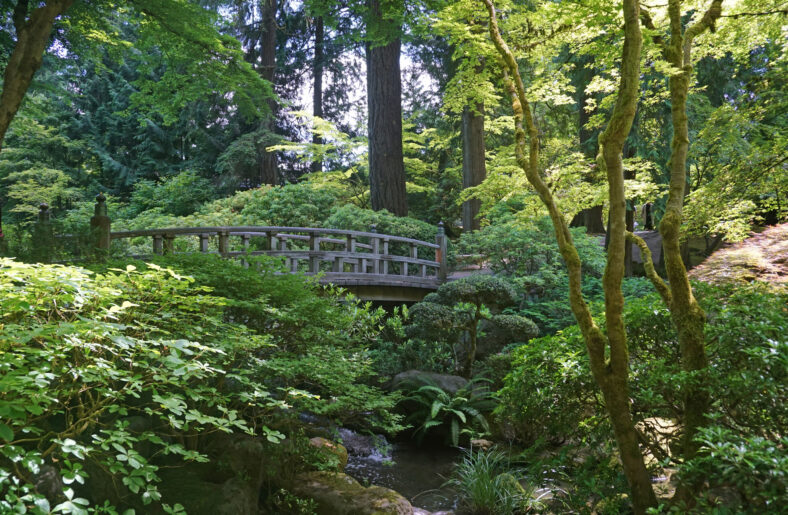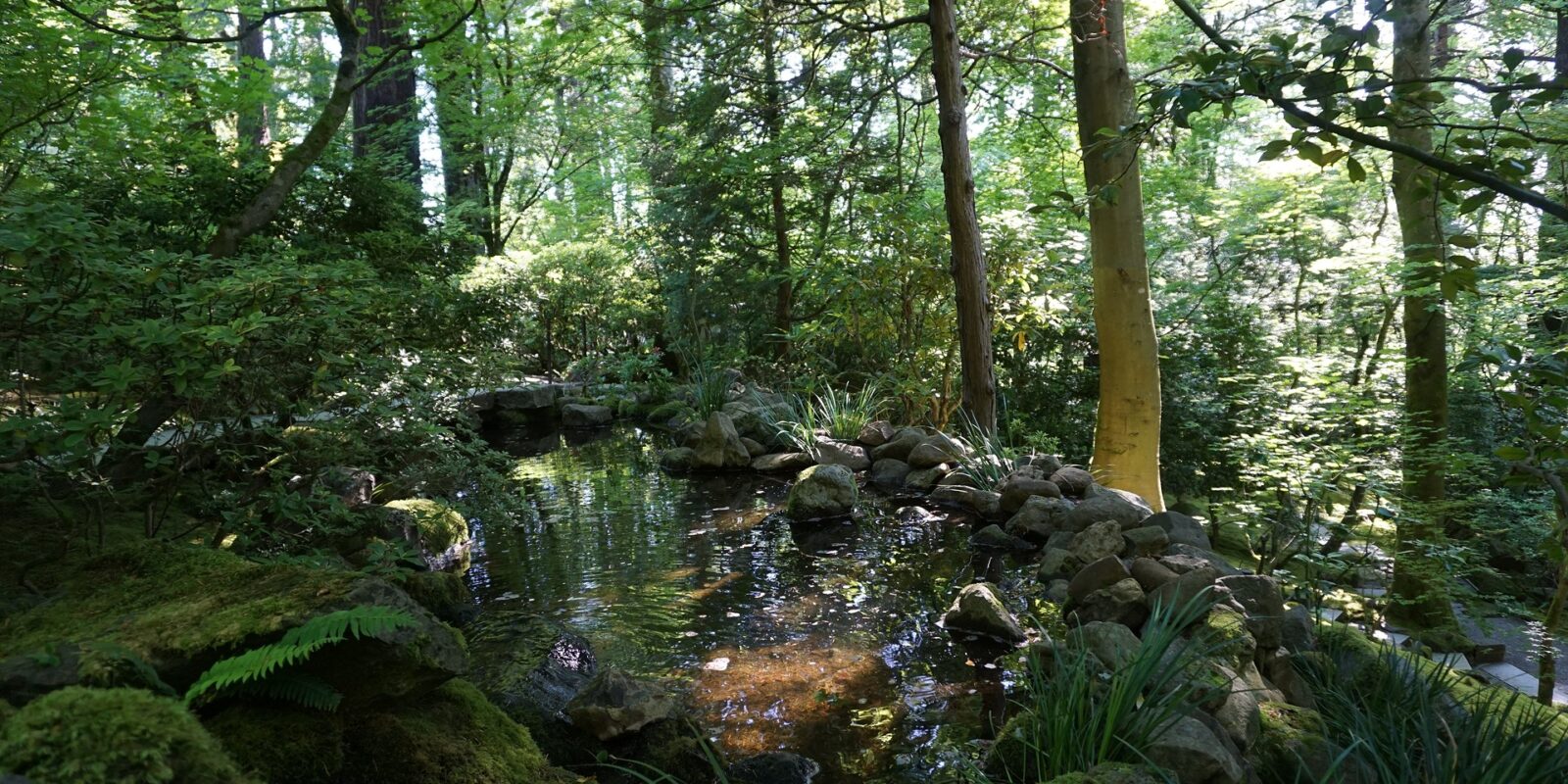In Portland Japanese Garden’s Natural Garden, everything lives. Sunlight mills in through corridors of tree limbs and creates pockets of warmth on moss and stone. Water flows at a steady pace, creating an undertone that perfectly harmonizes with the gentle sway of branch and leaf. If a person rests in this green bastion, they will feel refreshed and centered. That’s because what they’re doing is something people have done to calm themselves since antiquity. Spending time in Portland Japanese Garden speaks to something deep within. You’re not visiting an attraction—you’re returning home.
It may feel like we have always lived in this world of steel, concrete, and gasoline, but the truth is that for 99.9% of humanity’s existence, we mostly lived among nature (Song et al., 2016). It was not even 250 years ago that we saw the start of the Industrial Revolution and a sea change in the arrangement of humankind, where we slowly dripped away from hither and yon into cities. It was only 13 years ago when, for the first time in human history, it was determined more of us lived in urban settings than rural (Ritchie & Roser, 2018). We evolved and determined our future in the wild and it will be millennia before this essential thread of our character is altered.

In 1982, Tomohide Akiyama, Director of the Japanese Forestry Agency, coined a term to describe the activity of spending time in a forest: shinrin-yoku, or “forest bathing” (Miyazaki, 2018). Shinrin-yoku is more than a kind thought, it is a rapidly developing field of research and increasingly recommended form of preventative care. In the time that has passed since Akiyama gave it a name, it has been established as a health program in Japan and inspired the foundation of associations around the world, including the Association of Nature and Forest Therapy here in the United States (Farkic et al., 2021). While there is more work to be done to fully understand how shinrin-yoku impacts human health, it does appear to be a balm for the mind and body.
There have been numerous experiments and field studies conducted and the results have been rosy. Forest bathing has been found to:
- Help in the regulation of blood pressure (Wen et al., 2019)
- Be beneficial to a person’s parasympathetic nervous system (sometimes called the rest and digest system), the toolkit our body uses to balance out the sympathetic nervous system that revs our adrenaline and heartbeat in times of stress. Shinrin-yoku in a forested area like Washington Park presses play on the rest and digest system, allowing the body to enter a state of relaxation (Farrow & Washburn, 2019).
- Improve the number of natural killer cells, which protect against disease by killing virally infected cells (Yu et al., 2017).

Research indicates forest bathing also provides a defense against the pangs of anxiety, stress, depression, and other inflictions on one’s mind. In recognition of its potential to help, Japan has included it in its national health service as an intervention for mental health (Clarke et al., 2021). Shinrin-yoku seems to have a positive impact on post-traumatic stress disorder, has been observed to have benefits for those dealing with insomnia, and has improved the mood of people with unhealthy alcohol use (Antonelli et al., 2021). One study even did something as simple as studying facial expressions and found that people became happier by spending a few hours in the embrace of green (Wei et al., 2020). Such is the power of the forest that even video of it can induce some of the same physical reactions (Hansen et al., 2017).
Read more about forest bathing in Portland Japanese Garden.
There is no singular way to practice forest bathing, nor is there an exact amount of time prescribed. Some practitioners suggest that a single session last from two to four hours, but some research has demonstrated that even 15 minutes can have beneficial short-term effects on mental health (Antonelli et al., 2021). There are a range of activities within forest bathing including walking, standing, sitting, and deep breathing all while being mindful of one’s senses (Farrow & Washburn, 2019). Dr. Yoshifumi Miyazaki of Chiba University, among the world’s foremost experts on shinrin-yoku and an author of a popular book on the subject, suggests turning off your phone and engaging in shikan shoyou, which translates to “nothing but wandering along.” “Pay attention to any areas of stiffness or pain the body and consciously relax them,” Miyazaki writes. “Become aware of your present mental and emotional states…Pay attention to the experience of walking and keep your awareness engaged in this experience. Be aware of the beginning, the middle and the end of your stepping. Walk as silently as possible.”
Will forest bathing in Portland Japanese Garden solve all your woes? No, but it can be your bulwark against the anxieties of today’s tumultuous times. As our chief curator, Sadafumi Uchiyama once expressed in an interview with The Dirt, “…We are a place, an occasion in time, to enable them to think and have conversation that otherwise may be harder to have elsewhere…Somehow the Garden brings emotional stability.” Join Portland Japanese Garden as a member and visit often—inner peace is here, in the green.

Works Cited
Antonelli, M., Donelli, D., Carlone, L., Maggini, V., Firenzuoli, F., & Bedeschi, E. (2021). Effects of forest bathing (shinrin-yoku) on individual well-being: An umbrella review. International Journal of Environmental Health Research, 32(8), 1842-1867. https://doi.org/10.1080/-09603123.2021.1919293
Clarke, F. J., Kotera, Y., & McEwan, K. (2021). A qualitative study comparing mindfulness and shinrin-yoku (forest bathing): Practitioners’ perspectives. Sustainability, 13(12), 6761. https://doi.org/10.3390/su13126761
Farkic, J., Isailovic, G., & Taylor, S. (2021). Forest bathing as a mindful tourism practice. Annals of Tourism Research Empirical Insights, 2(2), 100028. https://doi.org/10.1016/-j.annale.2021.100028
Farrow, M. R., & Washburn, K. (2019). A review of field experiments on the effect of forest bathing on anxiety and heart rate variability. Global Advances in Health and Medicine, 8, 2164956119848654-2164956119848654. https://doi.org/10.1177/2164956119848654
Hansen, M. M., Jones, R., & Tocchini, K. (2017). Shinrin-yoku (forest bathing) and nature therapy: A state-of-the-art review. International Journal of Environmental Research and Public Health, 14(8), 851. https://doi.org/10.3390/ijerph14080851
Miyazaki, Y. (2018). Shinrin yoku: The Japanese art of forest bathing. Timber Press.
Ritchie, H. & Roser, M. (2018). Urbanization. Our World In Data.org. https://ourworldindata.org/-urbanization
Song, C., Ikei, H., & Miyazaki, Y. (2016). Physiological effects of nature therapy: A review of the research in Japan. International Journal of Environmental Research and Public Health, 13(8), 1-1. https://doi.org/10.3390/ijerph13080781
Wei, H., Ma, B., Hauer, R. J., Liu, C., Chen, X., & He, X. (2020). Relationship between environmental factors and facial expressions of visitors during the urban forest experience. Urban Forestry & Urban Greening, 53, 126699. https://doi.org/10.1016/j.ufug.2020.126699
Wen, Y., Yan, Q., Pan, Y., Gu, X., & Liu, Y. (2019). Medical empirical research on forest bathing (shinrin-yoku): A systematic review. Environmental Health and Preventive Medicine, 24(1), 70-70. https://doi.org/10.1186/s12199-019-0822-8
Yu, C., Lin, C., Tsai, M., Tsai, Y., & Chen, C. (2017). Effects of short forest bathing program on autonomic nervous system activity and mood states in middle-aged and elderly individuals. International Journal of Environmental Research and Public Health, 14(8), 897. https://doi.org/-10.3390/ijerph14080897
